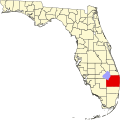Juno Beach, Florida | |
|---|---|
| Town of Juno Beach | |
 | |
 Location of Juno Beach in Palm Beach County, Florida | |
| Coordinates: 26°52′24″N80°3′15″W / 26.87333°N 80.05417°W | |
| Country | |
| State | |
| County | |
| Incorporated | 1953 [1] |
| Government | |
| • Type | Council-Manager |
| • Mayor | Alexander Cooke |
| • Vice Mayor | Peggy Wheeler |
| • Councilmembers | D.D. Halpern, and Vice Mayor Pro Tem Marianne Hosta |
| • Town Manager | David Dyess |
| • Town Clerk | Caitlin E. Copeland-Rodriguez |
| Area | |
• Total | 2.72 sq mi (7.05 km2) |
| • Land | 2.04 sq mi (5.28 km2) |
| • Water | 0.68 sq mi (1.77 km2) |
| Elevation | 23 ft (7 m) |
| Population (2020) | |
• Total | 3,858 |
| • Density | 1,891.7/sq mi (730.39/km2) |
| Time zone | UTC-5 (Eastern (EST)) |
| • Summer (DST) | UTC-4 (EDT) |
| ZIP code | 33408 |
| Area codes | 561, 728 |
| FIPS code | 12-35850 [3] |
| GNIS feature ID | 0284999 [4] |
| Website | www |
Juno Beach is a town in Palm Beach County, Florida, United States. Juno Beach is home to the headquarters of Florida Power & Light, the Loggerhead Marinelife Center and the Seminole Golf Club. It is home to one of the most dense sea turtle nesting areas in the world. [5] In 2023, the Loggerhead Marinelife Center recorded a record-breaking 25,025 sea turtle nests on their 9.5-mile stretch of beach. This included 15,672 loggerhead nests, 9,137 green turtle nests, and 216 leatherback nests, producing more than one million hatchlings. [6] It was also the original county seat for the area that was then known as Dade County. Juno Beach is in the Miami metropolitan area. The political climate in Juno Beach is leaning liberal. [7] The property crime rate is around the US national average, with the violent crime rate well below average. [8] The Town of Juno Beach was officially incorporated in 1953. [1] As of 2020, the town's population recorded by the U.S. Census Bureau was 3,858.








